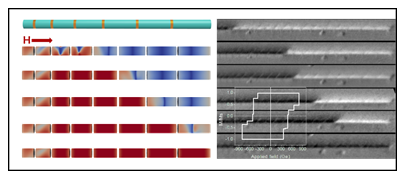Cerdanyola del Vallès, 26th June 2018. The magnetic ratchet effect, which represents a linear or rotary motion of domain walls in only one direction preventing it in the opposite one, originates in the asymmetric energy barrier or pinning sites. Up to now it has been achieved only in limited number of lithographically engineered planar nanostructures. The aim of the experiment was to design and prove the one-directional propagation of magnetic domain walls in cylindrical nanowires.

Unidirectional propagation of magnetization as seen in micromagnetic simulations and XMCD-PEEM experiments.
The research team was able to prepare cylindrical FeCo/Cu nanowires (made of iron, cobalt and cooper) with tailored increased lengths of the FeCo segments and to promote a stepped unidirectional propagation of magnetization. The multisegmented nanowires were prepared by electrodeposition into porous alumina templates. By adjustment of the electrodeposition conditions, such as the pulse scheme, alternating segments of Cu and ferromagnetic FeCo alloy could be fabricated. The FeCo segments are built with a wide range of lengths (300–1000 nm), while the Cu segments are kept constant at 30 nm. To get a full picture of the magnetic configuration the nanowires were measured by synchrotron light: X-Ray Magnetic Circular Dichroism-Photoemission Electron Microscopy (XMCD-PEEM) in CIRCE beamline; allowing “to see” the magnetic structure not only at the surface but also at the core of the nanowire.
The observed magnetization ratchet effect originates in the asymmetric potential from the designed increasing lengths of ferromagnetic segments, and as in a domino effect, it is promoted by the magnetostatic coupling between adjacent segments. The magnetization reversal in neighboring segments propagates sequentially in steps starting from the shorter segments, irrespective of the applied field direction.
The ratchet effect in multisegmented cylindrical nanowires constitutes a promising and simple route towards control of magnetic domain walls in future 3D magnetic memories.
Reference: Cristina Bran, Eider Berganza, Jose A. Fernandez-Roldan, Ester M. Palmero, Jessica Meier, Esther Calle, Miriam Jaafar, Michael Foerster, Lucia Aballe, Arantxa Fraile Rodriguez, Rafael P. del Real, Agustina Asenjo, Oksana Chubykalo-Fesenko, and Manuel Vazquez, Magnetization Ratchet in Cylindrical Nanowires, ACS Nano 2018 DOI: 10.1021/acsnano.8b02153.




